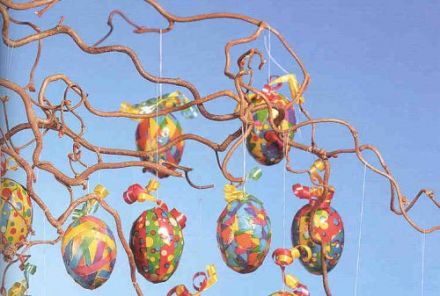 |
Happy Easter from Germany, or Frohe Ostern!
Of all the symbols associated with Easter (Ostern in German), the egg - the symbol of new life - is the most identifiable. Boiling eggs and decorating them began in Germany, where Easter eggs were painted in bright colors to represent spring sunlight and new growth. These eggs, along with other Easter gifts, were given to children. Today, most children prefer a delicious assortment of German chocolates, handmade truffles, pralines or candies in their Easter baskets.
Because of the rabbit's famed fertility, it became a symbol of spring fecundity. The Easter bunny was first mentioned in German writing in the 1500s. German children believe that if they are good, the Osterhase will lay a nest of colored eggs and hide them throughout the house. In the early 1800s, the first edible Easter bunnies were made in Germany from pastry and sugar.
Each region has its individual traditions. Though Easter eggs are most often brought by the Easter bunny, he is sometimes replaced by his wild counterpart, the hare. Birds are also often associated with Easter, so that in Tyrol you'll find a chicken and in the Hanover region a cuckoo… but don't be surprised to find roosters if you're traveling through Bavaria, or foxes in Thuringia and Westphalia.

Easter trees (Osterstrauch) have long been part of German Easter celebrations. These trees are decorated with hollowed-out eggs, which are dyed and hung with colorful ribbon throughout the week of Easter. Fancifully hand-painted eggs can sell for several dollars each in stores, but these traditional eggs can be made at home just as easily and more authentically!
The Thursday before Easter (Maundy or Holy Thursday in English) is called Gründonnerstag in Germany. Though the name means "green Thursday," it actually derives from greinen, an old German word for mourning or crying. On that day it's traditional to eat green dishes such as "seven herb soup" containing spinach, parsley, leeks, chives, dandelion and sorrel. On Good Friday - Karfreitag in German - people traditionally eat fish for dinner with their family. But the high point of German Easter celebrations is, of course, Easter Sunday. The whole family gathers together to celebrate the resurrection of Jesus and the end of Lent with a festive meal. A very common dish is lamb since it represents innocence and humility.
But the tradition doesn’t stop there. Because bunches of herbs were bought to prepare the Holy Thursday meal, there are always some left over. And so they are used to make Eier in gruener Sosse, eggs in green sauce. This green sauce is a traditional accompaniment to eggs, but you could also serve it with white asparagus... or why not both eggs and asparagus, to create a more substantial first course or a light meal.

-

 Recipes
Recipes
-

 Products
Products
-

 Entertaining
Entertaining
-

 Chefs
Chefs
-

 Hints & Tips
Hints & Tips
-

 Glossaries
Glossaries








